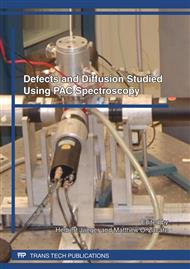p.3
p.39
p.62
p.105
p.137
p.159
p.167
Comparison of Jump Frequencies of 111In/Cd Tracer Atoms in Sn3R and In3R Phases Having the L12 Structure (R = Rare-Earth)
Abstract:
Measurements were made of jump frequencies of 111In/Cd tracer atoms on the Sn-sublattice in rare-earth tri-stannides having the L12 crystal structure via perturbed angular correlation spectroscopy (PAC). Phases studied were Sn3R (R= La, Ce, Pr, Nd, Sm and Gd). Earlier measurements on isostructural rare-earth tri-indides showed that the dominant diffusion mechanism changed along that series [4]. The dominant mechanism was determined by comparing jump frequencies measured at opposing phase boundary compositions (that is, more In-rich and more In-poor). Jump frequencies were observed to be greater at the In-rich boundary composition in light lanthanide indides and greater at the In-poor boundary composition in heavy-lanthanide indides. These observations were attributed to predominance of diffusion via rare-earth vacancies in the former case and indium vacancies in the latter. Contrary to results for the indides, jump frequencies found in the present work are greater for the Sn-poor boundary compositions of the stannides, signaling that diffusive jumps are controlled by Sn-vacancies. Possible origins of these differences in diffusion mechanisms are discussed.
Info:
Periodical:
Pages:
159-166
Citation:
Online since:
March 2011
Price:
Сopyright:
© 2011 Trans Tech Publications Ltd. All Rights Reserved
Share:
Citation:


